During painful periods herbs can help by supporting the job the body is already doing. Using Herbal tea for painful periods is a natural alternative to over the counter medications.
The Curse – For Women Only: (Guys, consider yourself warned.)
Whether you call it “The Curse”, or are more sarcastic and call it “My Friend” or “Aunt Flo” or embrace your spirituality and call it “Moon Time”, for many women it’s punishing. Painful periods include cramping, sweating, diarrhea, bloating, backaches, joint pains, headache, muscle weakness, fatigue, anxiety, and depression.
When I was a teenager, my doctor said, “Go on the pill” and things will straighten out. When “the pill” didn’t work but instead made it worse, the doctor said, “Get pregnant. Once you’ve had a baby it doesn’t hurt anymore.” Well, I was single. No wonder my Mother called it “The Curse”.
During that time I took Tylenol™, and then Motrin™ or Advil™. But they never really took the pain away, stopped the bloating, or the aches. Those pills just clouded my thinking, made me dizzy, but I still felt the pain. And that feeling of being out-of-control and drugged increased my anxiety.
When I had my first baby, I had a reprieve of 8 months. No period, no cramps. But when I started menstruating again, the cramps came back. That sucked. The Doctor lied.
After my third baby, to save some money, I stitched up some flannel menstrual pads from a pattern I found on the internet. A side effect of saving money was that my cramps lessened by about ½. You see the bleach and chemicals in the commercial pads were causing part of my pain. The heaviness of my flow lessened as well.
I’m past this wonderful stage of life now. But no sooner did I move into menopause then my daughter entered the wonderful stage. And with her menses came cramping, bloating, moodiness, and all the other symptoms I used to have. Thankfully, I knew how to help. Unlike the doctor’s advice which was an insult, this herbal tea for Moontime really helps.
What I learned from painful menses
During your period your body is cleansing.
Your body is ripe for elimination. It is trying to get rid of the wasted lining of your uterus. It is also ridding your body of toxins and other waste products. This is why women get loose bowel movements, fluid retention, and more urgency on the toilet during their monthly menses. It’s important to help your body do its job of elimination during this time.
Clean eating lessens the cramps
If you ate a diet of junk food all month, the toxins from your diet are going to increase your blood flow, and pain during your menses. If you took a lot of chemical medicine, the by-products that you didn’t eliminate earlier in the month will be dealt with during your menses. It’s the body’s way of cleaning up your act. Eat a healthy diet of fruits, vegetables, and organic food and less sugar and lab-created food, for an easier period.
Using organic cotton pads and a keeper cup lessens the cramps
If you use pads and tampons that are made from toxic cotton, bleached paper, or plastic, your body will absorb these toxins through your delicate parts. The cramps intensify as your body’s toxic load increases.
At least that’s my theory. I don’t have a scientific study to back it up. Just personal experience. Using organic cotton pads instead of the commercial disposable pads cut my cramps. It did the same for my daughter. Now it didn’t take the cramps away 100%. It made them bearable without OTC drugs.
You can make your own cotton pads using organic cotton flannel. Or buy reusable pads on the internet. Gladrags sells them here. If you have very severe cramps try switching to organic cotton cloth pads.
If you are a tampon user try switching to a Moon Cup. It’s a reusable cup that is inserted like a tampon. The Moon Cup catches your flow without the mess. You empty it, rinse, and reinsert several times a day. It’s both cheaper and safer than bleached disposable tampons. Find out more from Glad Rags here. The Moon Cup is made of silicone and is less prone to triggering allergy than the Keeper Cup, which is made from latex. Either option will last for years, so the upfront cost is small compared to buying disposable tampons. (Note: choose size A after you’ve given birth; size B for older teens and adults who have not given birth)
Herbs that help elimination can help lessen painful periods
During painful periods herbs can help by supporting the job the body is already doing. This isn’t the time for harsh elimination drugs. But supporting your liver, kidney, bowel, and uterus during this time will help lessen the pain. Adding herbs that reduce inflammation can also help. Since painful periods increase anxiety and moodiness, adding a calming herb like chamomile can help, too.
I picked these herbs because I can easily grow them in my zone 3 climate (except ginger which I can buy at the grocery store). There is nothing magical about these specific herbs except that they are local to me. It frustrates me when an herbal recipe calls for exotic ingredients but a common local herb would have sufficed. How to Plan Your Medicinal Herb Garden For Less Toil and More Fun
So use this recipe as a guide for your own herbal alchemy.
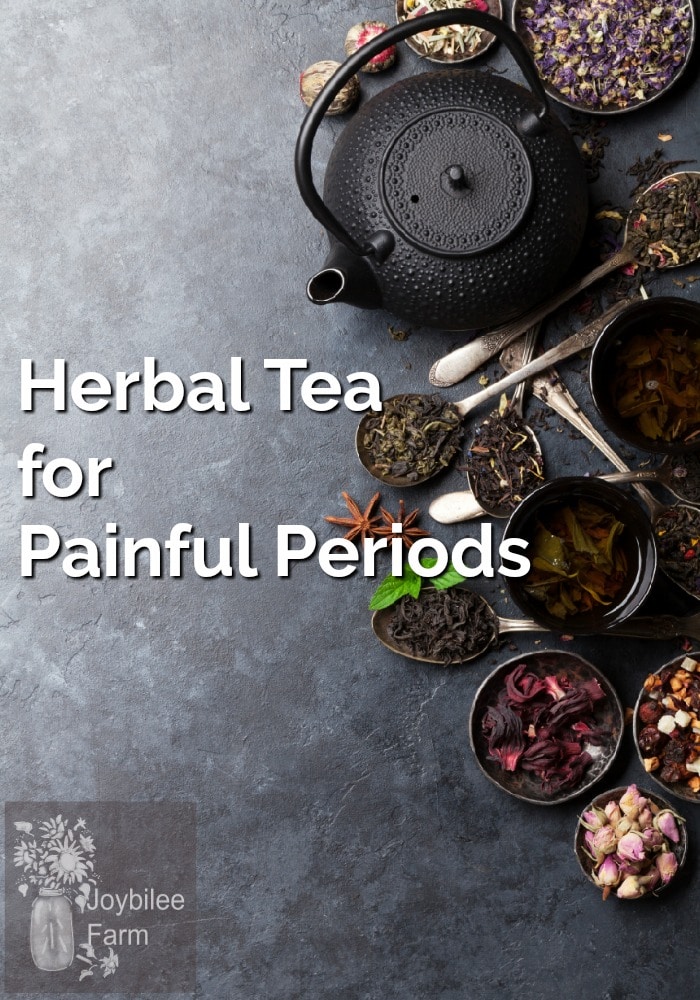
Herbal Tea for Painful Periods
All herbs are dried herbs.
Ingredients:
1 part Raspberry Leaf, crumbled
1 part Chamomile flowers, dried
1 part Peppermint leaves, crumbled
1/2 part Calendula blossoms, crumbled
½ part Motherwort leaves, crumbled
½ part Cramp Bark or Black Hawthorn Bark, shredded
¼ part Marshmallow Root, shredded
1/8 part Ginger powder
Method:
Mix the dried herbs and store them in a glass jar, in a cool, dark cupboard. This will last a year or more without loss in potency.
To use place 1 tsp of the dried herb mixture in a tea ball. Pour boiling water over the tea ball, in a teapot with a tight-fitting lid. Allow steeping for 5 minutes.
Drink hot for period cramps, as often as necessary. Put in tea bags for travel.
If you are travelling or leaving home for the day and need to take your herbal tea with you, consider the convenience of a tincture. A tincture allows you to carry the herb mixture with you. You don’t need to boil water or even find a place to sit down. You can carry a tincture with you on an airplane in your carry on. Label it well, and put it with your liquids in a Ziploc bag.
Tincture for Painful Periods
Mix the ingredients as listed using a ½ cup as the part. It will look like this:
½ cup Raspberry Leaf
½ cup Chamomile
½ cup Peppermint
¼ cup Motherwort
¼ cup Cramp Bark or Black Hawthorn Bark, shredded
2 tbsp. Marshmallow Root
1 tbsp. Ginger powder or 2 tbsp. freshly grated ginger
Place the ingredients in a 1 quart, wide-mouth mason jar. Pour vodka over the herbs, filling up the jar. Place a tight-fitting lid on the jar. Place the jar in a cool, dark cupboard. Shake the jar once a day or as often as you think of it.
After 5 to 6 weeks, strain the herb, reserving the liquid. You can compost the herb. Put the tincture in a dark, glass, bottle with a drop reducer to prevent spills.
To use take 1 tsp. 3 times a day, or as often as needed for painful periods.
Herbal tinctures last for years without loss of potency.
What do these herbs add to the mixture?
Red Raspberry leaves, Blackberry, Dew Berry, (Rubus spp.) – Astringent, tonic, alterative, anti-emetic, antiseptic, hemostatic, parturient
Raspberry leaves are useful for all females both human and animal. They are the herb of choice for conditioning the muscle of the womb for childbirth and after childbirth. Raspberry leaves bring balance both calming uterine cramps during painful periods while helping rid the body of waste. Leaves of Red Raspberry are the most documented in the literature but other bramble berry plants can be used effectively in this tea.
Chamomile (Maticaria Recutita) – Nervine, antispasmodic, carminative, anti-inflammatory, antimicrobial, bitter, vulnerary
Chamomile is calming, relaxing the nerves and calming painful periods. It supports the liver, as all bitter carminative herbs do, and it reduces inflammation.
Peppermint (Mentha x Piperita) – Carminative, anti-inflammatory, antispasmodic, aromatic, diaphoretic, anti-emetic, nervine, antimicrobial, analgesic.
Peppermint disguises the flavours of the more bitter herbs in this blend. It has its own cramp relieving, and calming action. It also relieves pain. It relaxes the stomach and relieves nausea, which sometimes accompanies painful periods. It eases anxiety and nervous tension and can relieve mild headaches.
Motherwort (Leonurus cardiac) – Nervine, emmenagogue, antispasmodic, hepatic, cardiotonic, and hypotensive.
Motherwort supports the liver. It relieves congestion in the pelvis. It will help bring on late periods. It relieves anxiety, while it’s antispasmodic action relieves painful periods. It is mildly bitter.
Cramp Bark (Viburnum opulus, Viburnum prunifolium)– antispasmodic, anti-inflammatory, nervine, hypotensive, astringent, emmenagogue, uterine relaxant
Cramp Bark, as implied by the name, has a reputation for relaxing muscle tension and spasm. It has traditionally been used to calm painful periods. Its astringent action reduces heavy period flow. It is relaxing to the uterus.
Calendula – anti-inflammatory, anti-spasmodic, astringent, lymphatic, emmenagogue. 5 Ways to Preserve and Use Calendula Flowers
Calendula helps with painful periods. It tones the tissue encourages lymph drainage, and gently supports the womb, while also supporting the liver.
Marshmallow Root (Althaea Officinalis) – demulcent, emollient, diuretic, anti-inflammatory. How to Harvest Marshmallow Root From the Spring Herb Garden
Marshmallow root soothes the mucus membranes. It is effective in easing bowel cramping and stomach upset during painful periods.
Ginger (Zingiber officinale) – Stimulant, carminative, antispasmodic, Rubefacient, diaphoretic, emmenagogue.
Ginger is anti-inflammatory and antispasmodic. Ginger stimulates circulation to the hands and feet, thereby relieving congestion and cramping. It eases nausea that sometimes accompanies painful periods. It has been shown to inhibit the actions of prostaglandins. It acts as a synergist to enhance the action of the other herbs. Warming Cayenne-Ginger Salve for Your Aching Back
The taste of this tea is mild and gentle. No need to add honey to disguise any bitterness. But of course, if you like your tea with honey, go ahead and add a little pleasure to your cup.
Want to know more about making herbal medicine?
New Release!
The Chestnut School of Herbs – Herbal Medicine Making Course is on right now. This class is an introduction to their full-length Herbal Immersion Program. If you enroll in the Herbal Medicine Making course and wish you’d pick the longer class, no worries. Students in the Herbal Medicine Making Course can apply their full tuition cost to the Herbal Immersion Program if they decide to go on to that course.
The Herbal Medicine Making Course is a 6-month course taught with both video and written materials. There’s a Facebook group to make learning more fun. (I’m loving the Facebook group). From now until January 20th there’s a $65 discount on tuition. Find out more here.
The more advanced Herbal Immersion Program is an intensive 18 month class with an emphasis on Botany, Cultivation, and medicine making. If you love plants and get satisfaction out of making your own medicines and crafting with herbs from your garden, you’ll love this course.
If you learn best with a class that engages all your senses with vibrant professionally done video, beautiful print materials, and hands-on, experiential learning, you’ll love this course. And lastly, if you are a kinesthetic learner, this is the best herbal course for you, hands down.
I’m really enjoying the emphasis on growing and making medicine from my own herbs. As I mentioned, I really dislike the dependence on imported exotic medicinal herbs that has come to characterize herbalism in North America. This class gives you a strong foundation in herbal medicine from the seed to medicine.
Back to You:
What have you found that helps you the most with painful periods? Leave a comment so that we can help each other.
Disclaimer: I’m an affiliate with the Chestnut School of Herbs, as well as The Herbal Academy. I am enrolled in the Herbal Medicine Making Course. I’d love to take the Herbal Immersion program, too. Last year I completed The Intermediate Herbal Program with The Herbal Academy, formerly HANES. Lifelong learner!
Learn more about using herbs for health and wellness from my Book

Homegrown Healing From Seed to Apothecary
My book Homegrown Healing From Seed to Apothecary will help you grow healing herbs in your own garden. Focusing on the easiest plants for beginners to grow, Homegrown Healing From Seed to Apothecary covers 30 plants, recommended by professional herbalists, that can be grown in the temperate zone. Initial garden preparation, garden design and harvesting tips lead the novice herbalist into early success. Choose which herbs to grow, learn how to use these herbs for your family’s health and wellness using the guidance in my book. You can find out more about this useful guide to growing more herbs and using them strategically here.


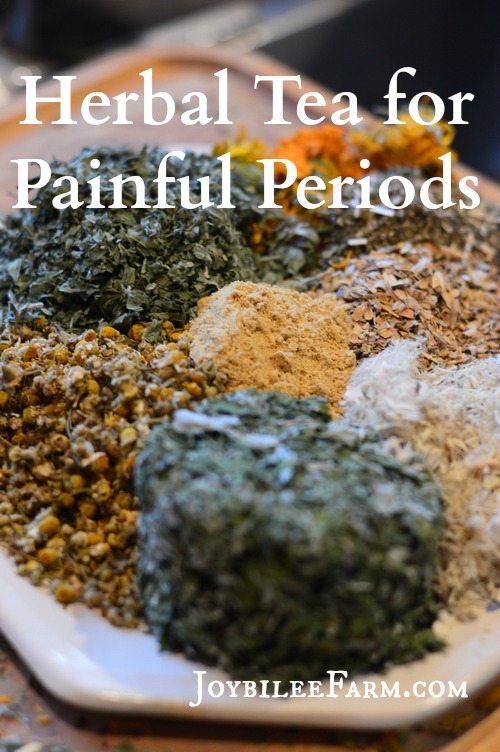
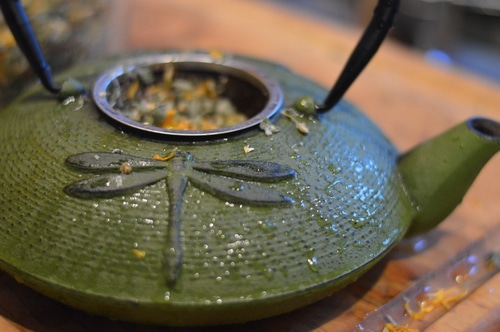
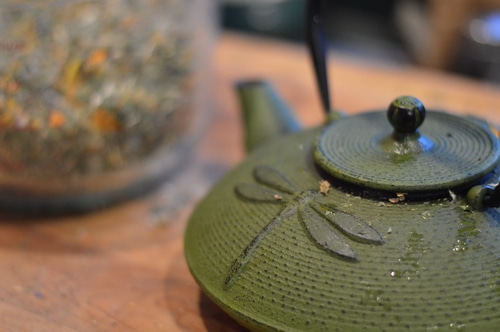
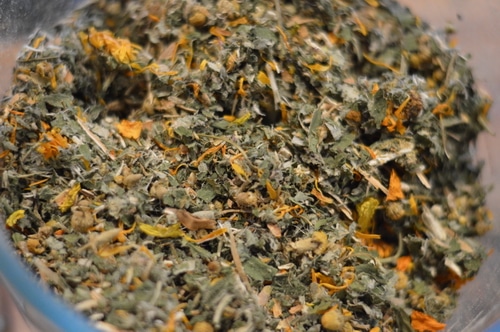

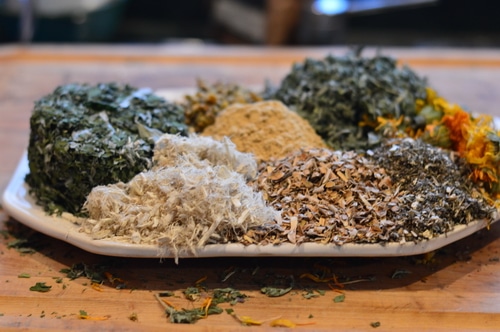
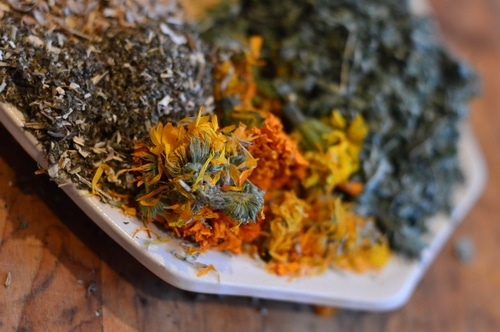


Thanks for sharing your tea tip!
Relaxant Emmenagogues are what’s needed for painful periods! I’m curious about making a tea blend from the following relaxant herbs, some of which need to be made by decoction. Any ideas?
Black Cohosh (Cimicifuga racemosa)
Black Haw (Viburnum prunifolium)
Blue Cohosh (Caulophyllum thalictroides)
Blue Vervain (Verbena hastata)
Chamomile (Matricaria recutita)
Crampbark (Viburnum opulus)
Lavender (Lavandula angustifolia)
Linden (Tilia europea)
Motherwort (Leonurus cardiaca)
Mugwort (Artemesia vulgaris)
Pasqueflower (Anemone pulsatilla)
Valerian (Valeriana officinalis)
Do you have any herbal info for menopause? I’d like help w mood swings stress and frustration and the exhaustion. I don’t seem to have any other issues yet….
Do you have an email, I have some info if you are open to it.
Lfg
You can contact us through the contact form on the “contact us” page. Thanks,
Oh I love this, do you have a blog I can follow? Nature has such an amazing medicine cabinet
thanks I gave brutal cramps,
I noticed you listed Calendula under the tea ingredients but not the Tincture ingredients, is there a reason for that?
Great article! I would also add some dried Mullein leaf. It is an anti-inflammatory specifically for the mucous membranes, so it’ll add a bit more pain relief.
Hi,
I obtained some organic raspberry leaf powder with the intention of using it for painful periods, however I can’t seem to find information online on how it can be taken, nor are there any instructions on the packet, so am wondering if you would be able to tell me how it is generally taken?
Thanks!
Usually as an herbal tea. If you have it as a powder you can put it into capsules and take it like a pill, but generally it is consumed as an herbal tea. The warmth of the tea is soothing.
I see that you shared the benefits of calendula, but I don’t see it listed in the ingredients. How much calendula should I add?
Hi, l have had very painful periods for a long time and the pain increased when l got fibroids. I would use diclofenac injection. But l started taking green tea daily with lemon and today l do not have the pains anymore. But one thing l have noted is that green tea and animal protein do not work together so l take like two hours after taking green tea to take any animal protein.
Good to know. Thanks for sharing. I’ll let Sarah know what works for you.
I’ve shared this theory with a lot of women and it also helps to cut down on meat consumption. I’ve always had very painful cramps and backaches but I realized that the months I cut meat out of my diet, I had minimal to no cramps at all. Another thing that helps with the bloating is lemons. Drinking room temperature fresh made lemonade or adding fresh squeezed lemon to my tea during menses took away the bloating.